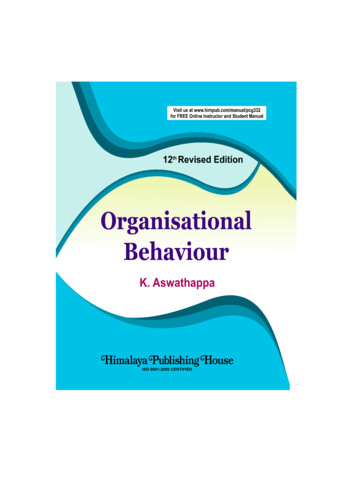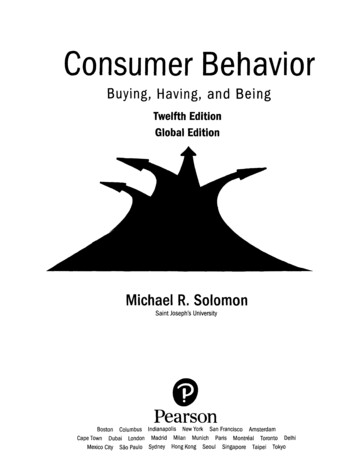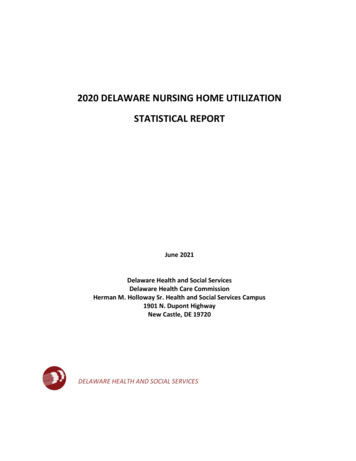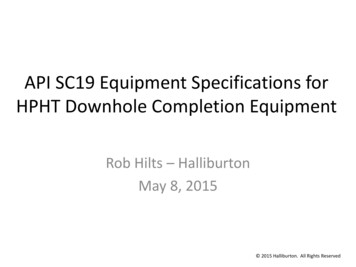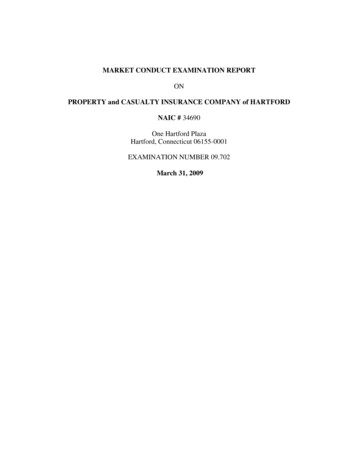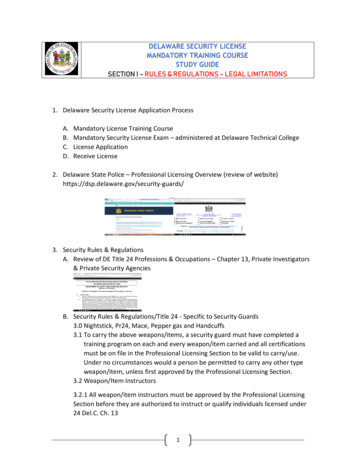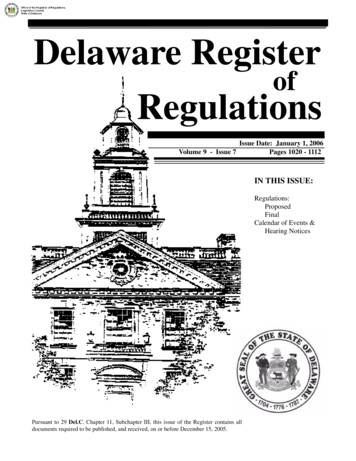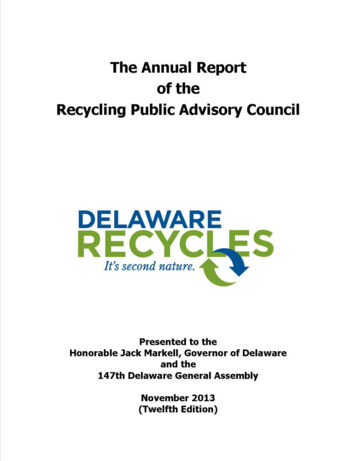
Transcription
Annual Report of the Recycling Public Advisory CouncilNovember 2013 (Twelfth Edition)This page intentionally left blank.To conserve our natural resources, please consider reviewing and distributing this document digitally before printing it.
Annual Report of the Recycling Public Advisory CouncilNovember 2013 (Twelfth Edition)The Annual Reportof theRecycling Public Advisory CouncilNovember 2013 (Twelfth Edition)Authored by:The Recycling Public Advisory CouncilEdited and Prepared by:The Division of Waste & Hazardous SubstancesDepartment of Natural Resources and Environmental ControlProduction of this Document Funded by:The Department of Natural Resources and Environmental ControlFor More Information Contact:Jim ShortSolid & Hazardous Waste Management SectionDepartment of Natural Resources and Environmental Control89 Kings HighwayDover, DE 19901Phone: (302) 739-9403Fax: (302) 739-5060E-mail: awm/Info/Pages/RPAC.aspxThis document is distributed electronically, but should always be printed on paper madewith 100% post-consumer recycled contentTo conserve our natural resources, please consider reviewing and distributing this document digitally before printing it.
Annual Report of the Recycling Public Advisory CouncilNovember 2013 (Twelfth Edition)This page intentionally left blank.To conserve our natural resources, please consider reviewing and distributing this document digitally before printing it.
Annual Report of the Recycling Public Advisory CouncilNovember 2013 (Twelfth Edition)Table of ContentsTable of Contents . iExecutive Summary . ii1.0 Purpose . 12.0 Background . 22.1 Benefits of Recycling . 22.2 Recent Recycling Efforts in Delaware . 23.0 RPAC Activities . 43.1 Measurement and Reporting . 43.2 Recycling Markets . 43.3 Outreach . 53.4 Other Activities . 54.0 Recycling Measurement Report . 64.1 Data Collection. 64.2 Diversion Rate Calculation. 64.3 Recycling Rates . 74.4 Behind the Data – CY2012 . 84.5 Status of the Recycling Goals . 105.0 Recycling Grants and Loans Program . 126.0 DNREC Activities. 156.1 Supporting the RPAC . 156.2 Supporting the Diversion of Yard Waste . 156.3 Implementing Recycling Legislation . 166.4 Public Education and Outreach . 167.0 DSWA Activities . 187.1 RECYCLE DELAWARE . 187.2 Universal Recycling Activities . 187.3 Public Education and Outreach . 198.0 Recommendations . 20AppendicesA Universal Recycling LawB Recycling Public Advisory Council MembersC DSM Measurement ReportD Outreach ExamplesE Background of Recycling Efforts in DelawareA-1B-1C-1D-1E-1To conserve our natural resources, please consider reviewing and distributing this document electronically before printing it.i
Annual Report of the Recycling Public Advisory CouncilNovember 2013 (Twelfth Edition)Executive SummaryWe have created an environment in Delaware that is increasingly supportive of recyclingactivities. In 2013 as a direct result of the Universal Recycling Law two new Material RecoveryFacilities (MRFs) began operations representing over 16 million in new investment and dozensof jobs. Now, for the first time ever we are processing our own source separated recyclables inDelaware. Before that, the statewide ban on yard waste in landfills led to the openings of largescale composting operations representing several million dollars in new investment and creatingmore jobs. These are all major advances both driven by and reflected in our increasing diversionrates. The fact of the matter is that we are turning more of our waste into a resource andsimultaneously driving valuable sustainable domestic industry as a result.There are many benefits to recycling which are often touted and occasionally debated.However, there is one impact which most people support and that must be acknowledged here:through a difficult period of economic recession, our recycling policies in Delaware have createdsignificant investments in new industry and new jobs. In the most recent study of Delaware’srecycling, reuse, and remanufacturing industry, recycling activities were estimated to have a 346 million direct positive impact on our State’s annual economy in CY2009. There have notbeen any subsequent studies but the economic contribution of these activities has undoubtedlycontinued to grow.To conserve our natural resources, please consider reviewing and distributing this document electronically before printing it.ii
Annual Report of the Recycling Public Advisory CouncilNovember 2013 (Twelfth Edition)The Recycling Public Advisory Council (RPAC) has 16 Members representing diverseinterests and has met regularly since the last report in November 2012. In addition to supportingand reporting on recycling activities, the RPAC is diligently working with all stakeholders tohelp implement the requirements of the Universal Recycling Law in the timeframes required. Amore detailed discussion of these efforts follows. This report covers recycling activities sinceNovember 2012 and recycling measurement for calendar year 2012.Recycling LegislationSince the signing of the Universal Recycling Law in June of 2010, the RPAC has focusedupon the implementation of the many elements of this law. The first major milestone of this lawwas single-family residential recycling, which was fully implemented by September 15, 2011.The next milestone was multi-family residential recycling, which was implemented on January 1,2013. The final component of this law is recycling in the commercial sector, which has animplementation deadline of January 1, 2014. A report describing the implementation plan forcommercial recycling was issued by the RPAC in November 2012.Recycling Grants and Loans ProgramThe RPAC has worked with the Department of Natural Resources and EnvironmentalControl (DNREC) to develop grant and loan guidelines as required by the Universal RecyclingLaw. The first cycle of the Universal Recycling Grant and Low-Interest Loan Program (grantprogram) funded twenty-two entities with over 4.8 million to primarily support residentialsingle-stream recycling. The second cycle of the grant program funded eight entities with over 325,000; prioritizing multi-family residential single-stream recycling projects. In June of 2013the grant contracts awarded during the third cycle of grant funding were signed. This grant cyclefocuses on commercial recycling and awarded nearly 1.4 million to a mix of fifteen differentmunicipalities, waste haulers, private businesses and not-for-profit entities. The fourth cycle ofthe grant program will support recycling efforts in the commercial sector, those areas that requirethe most help, and those areas where the greatest diversion impact would be realized.Outreach and EducationThe RPAC believes that efforts to increase the awareness and benefits of recycling arecritical to improving how waste is managed in Delaware. Therefore, the RPAC has worked withthe DNREC and the DSWA to develop and implement outreach efforts. This has included suchitems as radio ads encouraging recycling, public meetings, billboards, and a how-to guide toinform individuals on what and how to recycle.Recycling DiversionThe RPAC has used the same methods to calculate recycling rates in Delaware since 2006.The methodology is objective, scientific, auditable, and consistent with the U.S. EnvironmentalProtection Agency’s (EPA) guidelines. A summary of the recycling rates produced using thismethodology since 2006 is shown in Table 1 below:To conserve our natural resources, please consider reviewing and distributing this document electronically before printing it.iii
Annual Report of the Recycling Public Advisory CouncilNovember 2013 (Twelfth Edition)Table 1. Recycling Rate Summary, CY 2006-2012.TonsCalendar 0.0%32.6%MajorMilestones¹ExecutiveOrder reestablishesRPAC. 233.7%37.4%40.1%UniversalRecyclingsignedinto lawCentral&SouthernYardWastebans takeeffect.Firstfullyear ofsinglefamily,singlestream¹For a detailed explanations of Delaware’s major recycling milestones see “Appendix E.Background of Recycling Efforts in Delaware”It is important to note that the commercial component of Universal Recycling, which is notrequired to be implemented until January 1, 2014, will not be reported until late 2015. With astatewide recycling rate of over 40% for Calendar Year 2012 and the full impact of the UniversalRecycling Law still to come; it may be possible that Delaware is on track to meet the goal of50% diversion of MSW by 2015.RecommendationsThe RPAC’s recommendations to Governor Markell and the General Assembly include stepsthey can take to increase the recyclables diversion rate:1. Provide RPAC the discretion to fund those purposes specifically identified in theoriginal Universal Recycling Legislation (7 Del. C. Chapter 60, Subchapter III, SolidWaste Recycling). In order to meet the diversion goals established under the UniversalRecycling Law, the RPAC estimates all of the funds from bottle fees will be required.2. Lead by example - require recycling in all state government facilities, including publicschools, the courts system, and the legislature. Many schools, legislative branch offices,and judicial branch offices are believed to lack effective recycling programs. The status ofrecycling in executive branch offices under Executive Order 18 should be measured.To conserve our natural resources, please consider reviewing and distributing this document electronically before printing it.iv
Annual Report of the Recycling Public Advisory CouncilNovember 2013 (Twelfth Edition)1.0 PurposeThis is the Annual Report of the Recycling Public Advisory Council (RPAC). The purposeof the report is to fulfill requirements of 7 Del. C., §6058, which directs the RPAC to prepare anannual report addressing the following:1. The status of attainment of the recycling goals specified in 7 Del. C., §6056;2. An accounting of the recycling grants and loans programs and recommendations forfuture funding of the programs;3. An assessment of the activities of both the DNREC and the Delaware Solid WasteAuthority (DSWA) in achieving the goals specified in 7 Del. C., §6056;4. An objective, auditable accounting of recycling rates for total solid waste, municipal solidwaste, and residential solid waste; and5. Such other recommendations as the RPAC shall deem appropriate.The Solid Waste Recycling Law (the Universal Recycling Law) is attached to this report asAppendix A. A list of the current RPAC members can be found in Appendix B.To conserve our natural resources, please consider reviewing and distributing this document electronically before printing it.1
Annual Report of the Recycling Public Advisory CouncilNovember 2013 (Twelfth Edition)2.0 Background2.1 Benefits of RecyclingThere is more to recycling than feeling good about the environment. It also has tremendouseconomic value. Recycling: Provides over 10 times more jobs than landfilling Creates local industry Extends the useful life of municipal landfills Reduces emissions of greenhouse gases Saves energy Conserves natural resources Reduces environmental damage from industrial, residential, and commercial waste Teaches environmental stewardship to individuals, business and governmentFor further detail and supporting documentation please reference The Sixth Annual Report ofthe Recycling Public Advisory Council, visit the RPAC website, or contact the Division of Wasteand Hazardous Substances, Solid & Hazardous Waste Management Section (see cover sheet).The Northeast Recycling Council, Inc. (NERC) produced the Recycling EconomicInformation Study Update: Delaware, Maine, Massachusetts, New York, and Pennsylvania inFebruary 2009. This report and its last two iterations are available on NERC’s website,www.nerc.org. An important note is that the Delaware recycling, reuse, and remanufacturingindustry has a 346 million direct positive impact on our State’s annual economy - and thisnumber is growing.2.2 Recent Recycling Efforts in DelawareThe State of Delaware has been promoting recycling since 1975, and a more extensivehistory of those efforts can be found in Appendix E. The following is a summary of recentrecycling efforts.Between May 1, 2012 and April 1, 2013 the multi-family grants were completed. The grantsfunds awarded were for the capital costs of providing multi-family collection equipment andoutreach and education materials. While not all grants in this cycle were geared toward multifamily recycling, most were consistent with the funding priority in this grant cycle.To conserve our natural resources, please consider reviewing and distributing this document electronically before printing it.2
Annual Report of the Recycling Public Advisory CouncilNovember 2013 (Twelfth Edition)In June of 2013 the grant contracts awarded during the third cycle of grant funding weresigned. This grant cycle focuses on commercial recycling and awarded nearly 1.4 million to amix of fifteen different municipalities, waste haulers, private businesses and not-for-profitentities.On May 3, 2013 Carpet Recycling Strategy Committee issued its report called for underSenate Joint Resolution No. 8. In summary, the Committee was unable to reach consensus onrecommendations on how to increase carpet recycling in Delaware with a goal of having 100%of all carpet removed in Delaware be diverted to a carpet recycling. When the full RecyclingPublic Advisory Council (RPAC) reviewed this report, it suggested that Delaware revisit thestatus of carpet recycling in another two years. At that time, Delaware will have better data oncarpet diversion and recycling due to the reporting requirements in the Universal Recycling Lawand the RPAC will be moving its efforts from residential solid waste to construction anddemolition waste.Between July 2012 and January 2013 the Zero Waste Working Group, which includedmembers that represented industry, retailers, DSWA, DNREC, recyclers, and severalenvironmental groups, met monthly to discuss and to present draft legislation that would lead tomore effective plastic bag management in Delaware. The group did achieve consensus on anumber of points including: fugitive plastic bags are a problem for infrastructure and wildlife inDelaware and education will be a part of any plan to reduce plastic bag waste. However, thegroup had divergent views and did not agree on any legislative recommendations. Somemembers independently lobbied to introduce a bill to continue the At-Store recycling program.This bill passed the House last legislative session and is expected to be introduced to the Senatethis coming session.Between November 1, 2012 and October 31, 2013 nineteen outreach and education trainingevents were held throughout the state in reference to grant opportunities, the implementation ofcommercial recycling, and general recycling outreach and education. For a detailed list of theseevents see Table 7 in section 6 of this report.On August 29, 2013 ReCommunity held its grand opening ceremony. The opening of astate-of-the-art Materials Recovery Facility marks a recycling milestone for the State ofDelaware. With the opening of this facility Delaware now possesses the capability to separateand market its own recyclables. As a result, not only are the profitability of these valuableresources maximized, dozens of valuable local jobs are also created in the process, and 15million in construction costs were added to the local economy. This chapter in Delaware’srecycling history is possible as a result of the high diversion of recyclables afforded by the state’sUniversal Recycling law. ReCommunity and DSWA should be commended for their partneringefforts.To conserve our natural resources, please consider reviewing and distributing this document electronically before printing it.3
Annual Report of the Recycling Public Advisory CouncilNovember 2013 (Twelfth Edition)3.0 RPAC ActivitiesOver the past year, the RPAC has continued to primarily focus its efforts on implementationof the Universal Recycling Law. This includes providing recycling grant and loan guidance,establishing recycling guidance and toolkits for residents and businesses, and measurement andreporting of the amount and percent diversion of recyclables from Delaware landfills.3.1 Measurement and ReportingPrior to the reinstitution of the current RPAC, a Measurement and MethodologySubcommittee developed a methodology for measuring recycling diversion rates based uponEPA guidelines. This methodology provides an objective and auditable approach to recyclingmeasurement which was relevant and repeatable. The Subcommittee’s name was subsequentlychanged to “Measurement and Reporting” but their work continues in the current RPAC and hasresulted in the seventh Recycling Measurement Report (included as section 4.0 of this report).Most importantly, these Recycling Measurement Reports establish a uniformly acceptedapproach that will make past, present, and future recycling measurements consistent andcomparable.The RPAC and DNREC have developed guidelines for the recycling industry to reportinformation as directed by the Universal Recycling Law (7 Del. C., §6056). To help protectproprietary business information, the RPAC has been using a consultant to collect recycling data.Because reporting on commercial recycling activities was not previously obligatory, theRecycling Measurement Report was limited to voluntary surveys. The new, legally requiredreporting system will generate a fuller and more accurate spectrum of data, and will result in abetter overall measurement of recycling in Delaware. The first reporting year with the new datacollection was 2011, which means this is the first report with the required industry reporting.This report includes the first full year of single-stream, single-family curbside data resulting fromthe first component of universal recycling implementation.3.2 Recycling MarketsPaul Bickhart (RPAC Member representing the recycling industry) and Michael Parkowski(RPAC Member representing DSWA) have key industry contacts providing information on thesale of collected recyclables. They have educated the RPAC on the status of recycling markets tobetter understand current industry circumstances. In late 2008, the markets for recycledcommodities declined sharply in response to the national and global economies. Later in 2009prices very slowly started to improve. The outlook continued to be positive into 2010, and wasrelatively strong and stable in 2011. Prices generally declined for some commodities andremained flat for others in 2012. In 2013 the overall recycling markets have been relatively flatwith little price movement up or down and on the low side of historical trends due to the weakglobal economy. Recent market trends have placed strong emphasis on material cleanliness withless tolerance for contamination. Delaware is well suited to meet these demands with themodern separation infrastructure that has recently been constructed. Furthermore, transportingTo conserve our natural resources, please consider reviewing and distributing this document electronically before printing it.4
Annual Report of the Recycling Public Advisory CouncilNovember 2013 (Twelfth Edition)materials adds approximately 12 per ton for every 100 miles of transit so processing materialslocally improves the economics for recyclables.3.3 OutreachThe RPAC, DNREC, and the DSWA have coordinated education of the public on thetransition into universal curbside recycling, better yard waste diversion, DSWA’s departure fromcurbside recycling, the transition out of beverage container deposits, recycling industry reportingrequirements, and the availability of a new recycling grant and loan program. Outreach effortswill continue. Educating the public is of very high importance to the RPAC and a necessary partof any successful program. Citizens might not know why they should recycle or how toparticipate. The RPAC has developed a Subcommittee to help guide outreach efforts, includinggeneral steps forward for DNREC and the DSWA. While the RPAC does not provide recyclingservices, they want to facilitate and encourage recycling among citizens. DNREC and DSWAoutreach efforts are described in Section 6, Section 7, and Appendix D.3.4 Other ActivitiesThe RPAC is committed to helping Delaware find better waste management practices.Regular meetings provide insight into a variety of topics. Most discussions and presentationsover the past year have focused on the implementation of the Universal Recycling Law. Asrequired in the Universal Recycling Law, RPAC submitted a report entitled “Recommendationsfor Implementing Universal Recycling in Delaware’s Commercial Sector” to the Governor andthe General Assembly, concurrent with the 11th edition of this report, in November 2012. Thatreport includes a Frequently Asked Questions (FAQ) section, as well as a series of commercialrecycling ‘toolkits’ to help various types of commercial entities (such as office buildings,restaurants, hotels, and supermarkets) comply with the Universal Recycling Law.RPAC continues to significantly contribute to the Universal Recycling Grant and LowInterest Loan Program by reviewing and scoring grant applications. In addition to the recyclinggrant program, in the past year the RPAC prepared a reporton carpet recycling, and participatedin meetings addressing single-use plastic bags. With DNREC’s assistance the RPAC alsocontinues to track recycling fee revenue. The revenues raised by the recycling fee have beenconsistently lower than initial projections. At current rates, the total amount collected by the endof 2014 will be about 14 million, or 64% of the original 22 million projected. The revenuesraised in 2013 are comparable with 2012, but are still well below projections.To conserve our natural resources, please consider reviewing and distributing this document electronically before printing it.5
Annual Report of the Recycling Public Advisory CouncilNovember 2013 (Twelfth Edition)4.0 Recycling Measurement ReportOriginally under Executive Order 90, the RPAC had been directed to use the U.S. EPA’sdefinitions of “recycling” and “municipal solid waste” and also to develop an “objective andauditable accounting of recycling rates for total solid waste, municipal solid waste, andresidential solid waste.” In response to this directive, the RPAC created the Measurement andReporting Subcommittee (M&R Subcommittee) comprising members of the RPAC, DSWA,DNREC, and the community. Pursuant to this directive, the M&R Subcommittee produced amethodology which was developed via an open and transparent process, recorded in such a waythat it could be easily understood by members of the general public, and which was fullyendorsed by each organization represented on the Council. This methodology has beenconsistently employed by the RPAC to analyze recycling data since CY2006 so that meaningfultrends and comparisons could be established. The M&R Subcommittee has continued to employthis methodology under the new Universal Recycling Law.4.1 Data CollectionThe M&R Subcommittee obtained data from DSM Environmental Services, Inc. (DSM) forCY2012. Their report, The State of Delaware Assessment of Municipal Solid Waste Recycling forCalendar Year 2012, is excerpted in Appendix C. In previous reports, DSM had collected dataon recyclable materials collected by private industry in Delaware, while DSWA collected its owndata and reported numbers directly to the RPAC. The RPAC then calculated commercial andresidential waste disposal and recycling estimates using both data sets. Starting with calendaryear 2011 data and again this year with the calendar year 2012 data, DSM collected data fromboth the DSWA and from private industry, and calculated recycling rates using methodologyconsistent with the M&R Subcommittee’s previous efforts.Calendar year 2012 represents the second year that private industry was required to report onrecycling activity, per the Universal Recycling Law. While reporting has notably improved as aresult of this requirement, DNREC and DSM continue to work with and pursue non-reporterswho are believed to have valuable recyclables generation data which is critical to calculating themost accurate diversion rate possible.The RPAC and DSM have worked to ensure that the methodology for data gathering isconsistent with EPA guidelines and that there is no double counting of recycling activities. Thesurvey work by DSM was funded by the DSWA for CY 2012, but program management hasbeen the responsibility of the RPAC.4.2 Diversion Rate CalculationThe waste stream can be broken down into two primary categories: Municipal Solid Waste(MSW) and non-MSW. Put simply, MSW is what most of us think of when we think of “trash” even though it contains a high percentage of valuable resources. The EPA’s guidance forcalculating recycling rates limits “recycling” to the category of MSW. Additional detailTo conserve our natural resources, please consider reviewing and distributing this document electronically before printing it.6
Annual Report of the Recycling Public Advisory CouncilNovember 2013 (Twelfth Edition)regarding definitions of recycling can be found in RPAC’s 2006 Annual Report and in“Measuring Recycling: A Guide for State and Local Governments” (EPA-530-R-97-011).Determining the percent diversion of recyclables from Delaware’s solid waste streaminvolves the following calculation:Diversion rate of recyclables (%) 100 XMSW recyclable s, tons divertedMSW recyclable s, tons diverted MSW , tons disposedThe methodology developed by the RPAC calculates the percent of recyclables diverted fromthe MSW stream, as well as the total tonnage of MSW being landfilled. It also subdivides resultsinto the residential and commercial sectors. These residential and commercial allocations weredeveloped based upon comprehensive waste composition studies conducted in 2006 and 2007,the best judgment of DSM, and the best judgment of the members of the M&R Subcommittee.Determining whether a material was generated by the commercial or residential sector cansometimes be difficult to resolve and is not always intuitive. Generally the EPA and the M&RSubcommittee allocate materials to the original ‘generator’ even though they may not be the onewho actually performs the recycling. For example, lead acid battery recycling performed by acommercial battery retailer would be attributed 80% to the residential sector becauseapproximately 80% of the batteries are generated from non-commercial vehicles. While this‘generator rule’ can be debated, it is consistent with general EPA guidelines and has been appliedconsistently since 2006.4.3 Recycling RatesSince CY2006, the RPAC has employed an objective, scientific, and auditable methodologyfor calculating recycling rates in Delaware that is consistent with the U.S. EPA’s guidelines. Asummary of the recycling rates produced using the aforementioned methodology is shown inTable 2 below:Table 2. Recycling Rates Summary, CY2006-2011.200620072008Diverted Recyclables (tons)248,410323,396318,002MSW Disposed823,479794,984741,143Total Municipal Solid Waste Diverted Recyclables MSWDisposed1,071,889 1,118,380 1,059,145Percent Diverted 9,147706,368991,9901,065,515 4,2061,013,49237.4%40.1%Results comparing the prior two year’s residential to commercial sector results for CY2011& CY2012 are shown in Table 3 below. The residential recycling rate continues to besignificantly higher than the commercial recycling rate in both years. It is important tounderstand that waste and recycling tonnages fluctuate on an an
November 2013 (Twelfth Edition) To conserve our natural resources, please consider reviewing and distributing this document digitally before printing it. The Annual Report of the Recycling Public Advisory Council November 2013 (Twelfth Edition) Authored by: The Recycling Public Advisory Council Edited and Prepared by:
